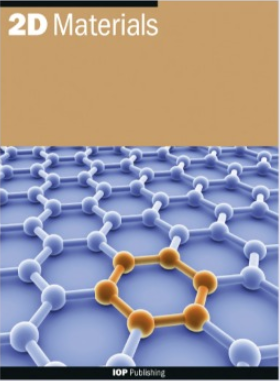高对称性构型的第 6 族过渡金属二钴化物同硅层和异硅层的精确结构和能量
IF 4.5
3区 材料科学
Q2 MATERIALS SCIENCE, MULTIDISCIPLINARY
引用次数: 0
摘要
二维 6 族过渡金属二钙化层(2D TMDC)双层膜显示出各种高对称性堆叠构型,在其扭曲的同层和异层双层膜中形成的扩展畴中也观察到了这些构型。这些堆叠构型的层间能量各不相同,能量差异决定了堆叠畴的相对大小。因此,精确预测与组成和堆叠有关的层间能量对于建立二维 TMDC 在其扭曲双层同质和异质结构中的畴结构模型至关重要。为了验证近似方法的有效性,我们仍然缺乏精确的参考数据。在此,我们在先前验证过的 SCAN-rVV10 几何结构上采用随机相近似法 (RPA),获得了 MX2(M=Mo、W,X=S、Se)双层的六种高对称性堆叠构型(Hhh、HhM、HhX、Rhh、RhM 和 RhX)的相互作用能,并将其与色散校正 DFT 函数 PBE-D3(BJ)、PBE-rVV10L 和 SCAN-rVV10 进行了比较,结果达到了最先进的精度。我们发现 SCAN-rVV10 是最可靠的 DFT 变体,其相对能量与 RPA 参考的平均偏差为 1.2 meV/原子,层间相互作用能量的均方根误差 (RMSE) 小于 2 meV/原子。我们发现 PBE-D3(BJ)得到的层间距离太短,对电子结构有影响,导致在某些情况下对带隙特性的预测不正确。这项研究的另一项成果是,在高能堆叠配置中,层间能量显著降低,层间距离显著增加。这些堆积可以通过剪切应变进入并促进剥离。本文章由计算机程序翻译,如有差异,请以英文原文为准。
Precise structure and energy of group 6 transition metal dichalcogenide homo- and heterobilayers in high-symmetry configurations
Two-dimensional group 6 transition metal dichalcogenide (2D TMDC) bilayers show various high-symmetry stacking configurations, which have also been observed in extended domains formed in their twisted homo- and heterobilayers. The interlayer energy varies for these stacking configurations, and the energy differences determine the relative size of the stacking domains. Therefore, the precise prediction of the composition- and stacking-dependent interlayer energy is crucial to model the domain structure of 2D TMDCs in their twisted bilayer homo- and heterostructures. For the validation of approximate methods that are necessary to tackle these systems encompassing thousands of atoms precise reference data is still lacking. Here, we employ the Random Phase Approximation (RPA) on previously validated SCAN-rVV10 geometries to obtain interaction energies of state-of-the-art accuracy on the six high-symmetry stacking configurations (Hhh, HhM, HhX, Rhh, RhM, and RhX) of MX2 (M=Mo, W, X=S, Se) bilayers and compare them with dispersion-corrected DFT functionals PBE-D3(BJ), PBE-rVV10L, and SCAN-rVV10. We identify SCAN-rVV10 as most reliable DFT variant with an average deviation of 1.2 meV/atom in relative energies from the RPA reference, and a root mean squared error (RMSE) of less than 2 meV/atom for interlayer interaction energies. We find interlayer distances obtained by PBE-D3(BJ) too short, with an impact on the electronic structure, which results in the incorrect prediction of the band gap character in some cases. A further result of this work is the significant lowering of interlayer energy and increasing of interlayer distance in the high-energy stacking configurations. These stackings can be accessible via shear strain and promote exfoliation.
求助全文
通过发布文献求助,成功后即可免费获取论文全文。
去求助
来源期刊

2D Materials
MATERIALS SCIENCE, MULTIDISCIPLINARY-
CiteScore
10.70
自引率
5.50%
发文量
138
审稿时长
1.5 months
期刊介绍:
2D Materials is a multidisciplinary, electronic-only journal devoted to publishing fundamental and applied research of the highest quality and impact covering all aspects of graphene and related two-dimensional materials.
 求助内容:
求助内容: 应助结果提醒方式:
应助结果提醒方式:


